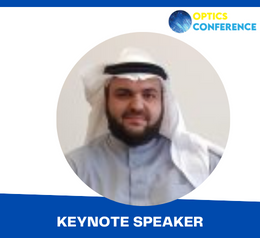Scholars 2nd Edition International Conference on
Optics, Lasers and Photonics
THEME: "A New Era towards Optics, Lasers & Photonics Technologies"
 27-28 Mar 2023
27-28 Mar 2023  Crowne Plaza Ealing, London, UK & Online
Crowne Plaza Ealing, London, UK & Online THEME: "A New Era towards Optics, Lasers & Photonics Technologies"
 27-28 Mar 2023
27-28 Mar 2023  Crowne Plaza Ealing, London, UK & Online
Crowne Plaza Ealing, London, UK & Online 
Taibah University, Medina, KSA
Title: Phase distributions of higher-order derivative coherent states (DCS)
Anas Othman is an associate professor at the physics department of Taibah University in Saudi Arabia. I received the MS degree from the University of Alberta (Canada) in physics major in 2014, and then I received Ph.D. from the University of Waterloo (Canada) in physics in the field of theoretical quantum optics in 2018. I then have been an assistant professor at Taibah University for four years, and recently in 2022 (June), I have been an associate professor. My research intersests mostly in theoretical quantum optics and mathematical physics. In particular, I am interested in controlling/manipulating quantum optics applications, emerging phenomena of light-matter interactions, and new quantum states/operators/definitions. I have published more than 13 peer-reviewed articles in ISI journals.
The near superposition technique is a certain overlapping of two semi-identical variable states. This technique has been employed in the coherent state (CS) and named near CS. Recently, the definition of near superposition has extended to higher orders and produced many possibilities of phases. One of the possible cases is the derivative limit in which all the phase differences vanish. This case is used in CS, and the resultant state is named the derivative coherent state (DCS). The DCS exhibits many remarkable features; one of them is that it displaces a stationary state which is a superposition of some Fock states that is not a function of the coherent parameter. Studying the quantum phase properties of DCS is of interest because DCS reveals many nonclassical properties. In this study, we theoretically operate some quantum phase measurements to DCS. Some of these are the quantum phase distribution, angular Q phase function, and Husimi quasiprobability distribution. The analysis of this examination indicates that DCS has two unique separate phases. The distinction between the two semi-classical phases is increased as the high order grows. The study suggests that the DCS is similar to the Schrodinger cat state, which overlaps between two contradicting statements.
[1] Anas Othman and David Yevick, Quantum Properties of the Superposition of Two Nearly Identical Coherent States, International Journal of Theoretical Physics, 57, 2293 (2018).
[2] Anas Othman and David Yevick, The characteristics of higher-order derivative coherent states (DCS), Journal of Modern Optics, 69, (18), 1032 (2022).